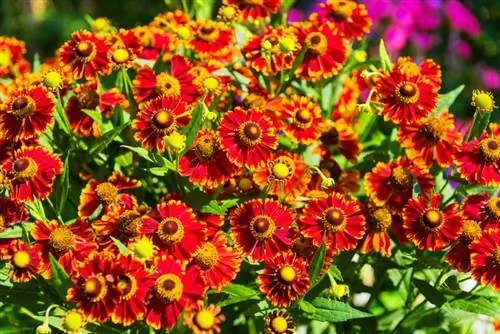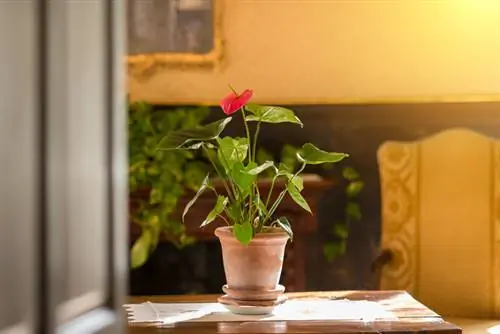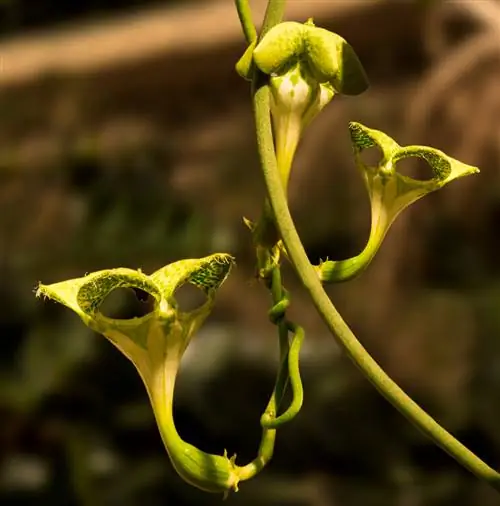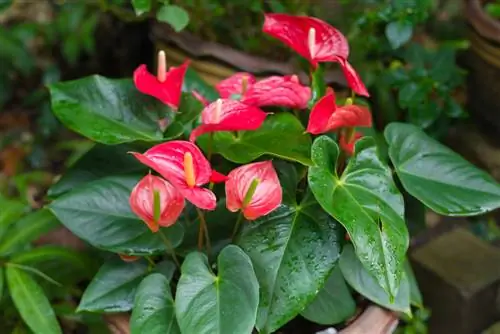- Author admin [email protected].
- Public 2024-01-10 23:11.
- Last modified 2025-01-23 11:21.
Anthuriums, also known as flamingo flowers, are very attractive houseplants with their large, shiny leaves and colorful inflorescences. No wonder they keep coming back into fashion. With a little attention, cultivation can be successful.
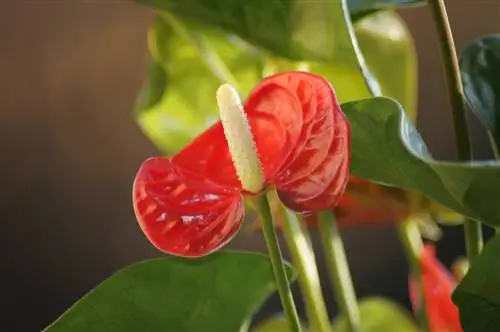
How do you properly care for anthuriums (flamingo flowers)?
Anthuriums, also known as flamingo flowers, are tropical houseplants with shiny leaves and showy inflorescences. They need a bright, warm location without direct sunlight, high humidity and loose, slightly acidic soil. Regular watering with low-lime water and weekly fertilization during the growing season are important for their growth.
Origin
The anthurium, also known as the flamingo flower because of its eye-catching inflorescences in reddish colors, originally comes from the neotropical areas of Central and South America and the Caribbean Islands. So it is an absolute rainforest plant and can only be kept as a houseplant. Of the total of around 1,000 species of the genus, only the large and small flamingo flowers (Anthurium andreanum and Anthurium scherzerianum) as well as hybrid breeds of both are widespread for the local window sill ornamental culture.
Growth
Anthuriums grow as evergreen perennials and reach heights of 40 to 100 centimeters and a width of around 30 to 60 centimeters. They belong to the epiphytes, so they usually settle on trees in the wild. But there are also species that grow terrestrially.
leaves
Biologically speaking, the anthurium is primarily a foliage plant. The most striking thing about it are its leaves, especially the colorful bract beneath the flower, the spathe, which serves as an attention-grabber for the actual flower. But the leaves are also a magnificent sight with their flat, elongated heart-shaped shape and their rich, medium green color. They have a slightly leathery consistency and are shiny. The bract shines in white, pink, hot pink or bright red and, at least in the case of the greater flamingo flower, also shines.
With the many species in addition to the large and small flamingo flowers, there is a much more diverse range of leaf shapes.
Let’s hold on:
- Leaves elongated heart-shaped and shiny
- leathery consistency
- Bract under the flower colorful
Bloom
The actual flower, to which the colored bract is usually perceived as belonging, is just the small piston that sits in the armpit of the spathe. It usually has an elongated cylindrical to club-like shape and a pale yellow, orange or red color. An inflorescence can be formed on any inflorescence - in late spring to early summer, around May to June, the flamingo flower can be covered in a real firework of color that stands out attractively against the lush green foliage.
Which location is suitable?
Anthuriums, like so many other rainforest plants, need a bright, warm, draft-free location without direct sunlight. So you should place the flamingo flower in a window spot where it is somewhat shaded by other houseplants. The temperature should be at 20°C and above; the anthurium thrives best at around 23 to 25°C. In winter it should be a little cooler, around 16 to 18°C - this will give it the necessary temperature stimulus, which will lead to good flowering after the winter break.
As a tropical plant, high humidity is of course good for the flamingo flower. It's best to treat her regularly to a fine mist spray shower from the water disperser.
To remember:
- Location must be warm and bright
- protect from direct sunlight and drafts
- high humidity
- Temperatures in summer between 20 and 25°C, in winter between 16 and 18°C
read more
What soil does the plant need?
As an epiphyte, the anthurium does not necessarily need a soil substrate, but can also be planted in pure peat. In this case, a regular supply of nutrients is necessary. A loose mixture of slightly acidic (orchid) soil is best, which you loosen up with peat, sphagnum or leaf mold. A high humus content is also highly recommended, so mix in some compost too. In any case, the substrate should be loose and well-drained.
You can also keep an anthurium hydroponically in an expanded clay substrate over a water-nutrient solution.
Watering anthurium
The water requirement of the flamingo flower is relatively high. So you should water abundantly. However, there should be no permanent footbath, otherwise root rot cannot be ruled out. Make sure the substrate is always moist. During the winter break, watering is reduced slightly. Important: If possible, use water that is low in lime and lukewarm. The anthurium is very sensitive to limescale and generally does not like cold.
Casting practice at a glance:
- Flamingo flower quite thirsty
- Always keep the pot ball moist
- Avoid waterlogging
- water less in winter
- Use low-lime, lukewarm water
read more
Fertilize anthurium properly
The flamingo flower should be fertilized in moderation, but in very small steps. It is best to add a small amount of liquid fertilizer (€6.00 on Amazon) in a low concentration to your irrigation water once a week during the growing season from spring to autumn. During the winter break, fertilizer application is greatly reduced or stopped completely.
- fertilize moderately but evenly throughout the growing season
- very little or not at all in winter
read more
Cut anthurium correctly
You don't have to cut the anthurium.
Propagate Anthurium
The flamingo flower is best propagated by root division. This method is particularly suitable in view of their clump-forming roots, which require annual repotting anyway. You can also use the pot change in spring for propagation.
When cutting the root ball, you must make sure that the section to be replanted has at least one leaf with well-developed, he althy roots. Place it in a pot with loose, slightly acidic and peaty soil and keep it bright and warm. For a uniform, warm, moist growing climate, it is recommended to initially cover the plant with a foil bag.
To remember:
- Division the best method of propagation
- best done in spring when repotting
- divided piece must have at least one leaf with developed roots
- Plant in a species-appropriate substrate and keep it warm and bright
- keep moist, possibly allow to grow under foil
read more
Share
How to divide a flamingo flower, read the “Propagate” section.read more
Diseases
Diseases are actually not an issue with anthurium. If she shows unhe althy symptoms, care errors are usually the cause. If necessary, the plant can be affected by leaf spot, a fungal disease. It manifests itself as brown spots on the leaves. Countermeasures include removing the diseased plant parts and applying a fungicide.read more
Pests
The flamingo flower can be attacked by certain pests, especially if the air in the room is too dry. Potential candidates are primarily spider mites and scale insects.
Spider mites
These small parasites often occur in houseplants that, contrary to their high humidity requirements, are exposed to dry heating air. The mites are very small, but can be seen with the naked eye, especially if they are of the reddish variety. But there are also greenish to white-yellowish species that can hardly be seen on the leaves. However, the infestation is clearly visible through the fine webs with which the mites cover the leaf axils and stems.
Fighting spider mites is fortunately relatively easy and at the same time corrects the care error that caused them: water is the element with which the annoying companions can best be driven away and which the plant usually lacks beforehand and is susceptible to in the first place for the infestation.
First, the spider mites can simply be sprayed off mechanically with a strong jet of water. The entire plant is then covered under a film while it is wet. In the humid and air-poor climate below, the mites usually die within a week.
Scale insects
Scale insects are also one of the most common pests on houseplants. They suck the plant sap from their host and secrete honeydew, which, in addition to worrying about their plants, also sticks up windows and windowsills for the hobby gardener.
Like spider mites, you can initially attack scale insects mechanically. Wipe the anthurium leaves thoroughly with a damp rag. Since the leaves are quite robust, you don't need to be too timid. If the infestation is more stubborn, you can also use a spray treatment with garlic, fern or nettle decoction. In very severe cases, you can use oil preparations that suffocate the lice.
Yellow leaves
If your flamingo flower has yellow leaves, it is usually due to a lack of light or a substrate that is too wet.
Lack of light
Providing the anthurium with the right lighting conditions is certainly not entirely trivial. It's a little difficult to get a lot of brightness without direct sunlight. However, natural, light shading from a neighboring plant on the windowsill or from a thin awning can be good solutions.
Waterlogging
Meticulous balancing is also the be-all and end-all when it comes to watering. Strictly regular watering, where the substrate is always moist but never in water, requires a lot of attention. If you don't want to go through that effort, you can also resort to hydroponics. Anthuriums generally thrive very well there.read more
Brown leaves
The leaves of the flamingo flower, on the other hand, are more likely to turn brown if there is too little sun protection, if the substrate is too impermeable, if there is root rot or if there is over-fertilization.
Lack of sun protection
Be sure to protect your anthurium from strong sunlight. Otherwise there is a risk of sunburn, which will weaken the plant in the long term.
Impermeable substrate
As an epiphyte, the flamingo flower needs a lot of air at the roots. It doesn't feel comfortable in a substrate that is too dense. Brown leaves may indicate that it cannot breathe adequately through the roots. So place them in a substrate that is as loose and peaty as possible.
Root rot
Brown leaves can also indicate an advanced condition due to overwatering - in the form of root rot. This condition is quite critical and requires repotting as soon as possible. Before placing it in the new pot, remove all rotten root components as thoroughly as possible and from now on only water to such an extent that the substrate does not dry out.read more
Brown spots
Brown spots usually indicate leaf spot disease. The best way to combat this fungal disease, like most other houseplant fungal diseases, is to carefully remove the affected parts of the plant and then use a fungicidal spray.read more
Is anthurium poisonous?
Unfortunately, anthuriums are slightly poisonous, in all parts of the plant. Like other arum plants, the leaves in particular also contain the saponin aroin and calcium oxalate, which the plant distributes to possible attackers via tiny needles. Therefore, just touching it can cause skin irritation in the form of redness, swelling and even blistering. However, the cultivated forms are usually not as poisonous as the wild forms.read more
Food
Eating parts of the flamingo flower is even more critical. It should be kept away from small children and pets in particular. Symptoms when consuming anthurium parts initially include redness and blistering of the mucous membranes of the mouth and throat as well as painful swelling of the tongue. If swallowed, nausea, vomiting and diarrhea will soon occur.
A suitable first aid measure is to drink a lot to help expel the poison. The symptoms usually go away on their own after 2-3 hours. In the worst case, larger quantities consumed can lead to gastrointestinal bleeding - in this case you should consult a doctor at the latest.
Is anthurium poisonous to cats?
Due to their small body mass, cats show symptoms of poisoning that are similar to those in humans even when they ingest small doses of flamingo flower parts. There is also increased salivation. Try to get the animal to drink. If symptoms are severe, consult a veterinarian quickly.read more
Varieties
When it comes to the question of which cultivar should be brought into the room, it is best to use the color of the spathe as a guide. It is the most characteristic thing about the different varieties. The other properties are largely the same.
Varieties of Lesser Flamingo Flower
The varieties are often crosses, but are still often classified as small or large flamingo flowers. The former develop somewhat smaller but more numerous inflorescences. They grow to a height of around 30 to 50 centimeters. The leaves are rather lanceolate and the spathe is only slightly heart-shaped in the armpit. It usually has little or no shine. The flowering period is between May and June.
Red Bract:
Anthurium scherzerianum Artus: This variety has an intense scarlet red, matt shiny spathe and a spadix flower that is usually also reddish.
Anthurium scherzerianum Rothschildianum: The bract of this variety has white spots on the red base color and therefore offers a particularly attractive, eye-catching sight.
Pink Bract
Anthurium scherzerianum Amaretti:With its pink spathe, this variety has a slightly more delicate appearance.
White Bract
Anthurium scherzerianum Album:This variety produces snow-white bracts with yellow spadix flowers.
Varieties of Greater Flamingo Flower
The varieties of Anthurium andreanum produce larger but less numerous inflorescences. The leaves are also larger with a blade of up to 40 centimeters, have a leatherier consistency, a shinier surface and a distinct heart shape. The great flamingo flower reaches a height of up to one meter. The flowers are produced between May and June.
Anthurium andreanum Princess Amalia Elegance:This variety looks particularly elegant and almost diva-like due to the scarlet, fine veining on the white spathe. The flower spadix is also in the same scarlet tone.
Anthurium andreanum Rosee Choco:This variety has a deep, reddish brown spathe and therefore appears very sublime.
Anthurium andreanum Acropolis:The inflorescences of this variety have a beautiful, large bract in creamy white and a white spadix flower that turns yellowish at the top.
Anthurium andreanum Calisto:This variety looks very interesting with its light green spathe and accents and flower spadix in pink.


